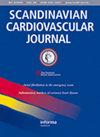桡动脉和隐静脉移植物闭塞的危险因素不同
IF 1.2
4区 医学
Q3 CARDIAC & CARDIOVASCULAR SYSTEMS
引用次数: 0
摘要
抽象目标。确定冠状动脉搭桥术(CABG)后长期随访中桡动脉和隐静脉移植物闭塞的危险因素。方法:从119名接受过桡动脉移植的患者队列中,76名患者(其中55名患者至少接受了一次隐静脉移植)在冠状动脉旁路移植术后7.6-12.1年(平均8.9年)接受了预先计划的直接血管造影术和人体测量、生化和内皮功能评估。还记录了合并症、药物和吸烟习惯。在单变量和多变量逻辑回归模型中分析了这些参数与导管寿命之间的关系。结果:桡动脉移植物闭塞与血浆高敏C反应蛋白水平升高有关,在药物治疗的高血压患者中,通畅性最好。隐静脉移植物闭塞的唯一独立危险因素是吸烟8-12 术后数年。结论:我们的数据支持这样一种论点,即桡动脉移植物衰竭的发病机制不同于静脉移植物疾病,并与高血压状态和全身炎症有关。这些风险因素是预防措施的潜在目标。因此,该研究支持最终设计个性化的二级预防方案。临床注册号:ISRCTN23118170本文章由计算机程序翻译,如有差异,请以英文原文为准。
The risk factors for radial artery and saphenous vein graft occlusion are different
Abstract Objectives. To determine risk factors for radial artery and saphenous vein graft occlusion during long-term follow-up after coronary artery bypass grafting (CABG). Methods: From a cohort of 119 patients who had received a radial artery graft, 76 – of whom 55 also had at least one saphenous vein graft – underwent a preplanned direct angiography and anthropometric, biochemical, and endothelial function assessment 7.6–12.1 (mean 8.9) years after CABG. Comorbidity, medication, and smoking habits were also recorded. The association between these parameters and conduit longevity was analyzed in univariable and multivariable logistic regression models. Results: Radial artery graft occlusions were associated with higher plasma levels of high-sensitive C-reactive protein and patency was best among patients with pharmacologically treated hypertension. The sole independent risk factor identified for saphenous vein graft occlusion was tobacco smoking 8–12 years postoperatively. Conclusion: Our data support the contention that the pathogenesis of radial artery graft failure is distinct from vein graft disease and is related to hypertension status and systemic inflammation. These risk factors are potential targets for preventive measures. Accordingly, the study supports the eventual design of personalized secondary prevention regimens. Clinical registration number: ISRCTN23118170
求助全文
通过发布文献求助,成功后即可免费获取论文全文。
去求助
来源期刊

Scandinavian Cardiovascular Journal
医学-心血管系统
CiteScore
3.40
自引率
0.00%
发文量
56
审稿时长
6-12 weeks
期刊介绍:
The principal aim of Scandinavian Cardiovascular Journal is to promote cardiovascular research that crosses the borders between disciplines. The journal is a forum for the entire field of cardiovascular research, basic and clinical including:
• Cardiology - Interventional and non-invasive
• Cardiovascular epidemiology
• Cardiovascular anaesthesia and intensive care
• Cardiovascular surgery
• Cardiovascular radiology
• Clinical physiology
• Transplantation of thoracic organs
 求助内容:
求助内容: 应助结果提醒方式:
应助结果提醒方式:


